Over the last ten years, I’ve experimented with a myriad of approaches to maximising my focus while working, writing, or creating music.
My hunt for the best way to focus has been fuelled by a simple reason: being ‘in flow‘ is immensely satisfying.
Flow is a state of mind that yields meaningful progress and breakthroughs, and at the end of a day where I’ve experienced flow, I feel calm and content.

A day of distraction, however, can be dizzying. If I haven’t been focused on my top priorities, an ambience of unease can seep into my evenings or even weekends.
The problem is, flow is elusive, and it’s especially elusive in my role as CEO of a company where a typical day involves dozens of decisions, projects, and problems to solve.
Getting into flow is relatively straightforward when you have an empty calendar and a singular project in front of you for the day.
It’s harder to achieve when you’re changing gear and context switching several times per day, and harder still when you’re trying to be responsive to your team.
In order to achieve flow, I’ve been working on ways of defending myself against distraction.

I don’t struggle with the classic forms of distraction during work, like YouTube rabbit holes or social media. Instead, if I’m not mindful of my priorities and my focus, it’s easy for me to get pulled into work that feels urgent but isn’t actually mission-critical. Work that won’t move the needle for the company.
So when I talk about distraction, what I’m really talking about is low-impact busy work.
An insidious form of distraction that can feel productive in the moment – if one isn’t mindful – without actually making a big impact.
Over the last couple of years, I’ve gotten into a particularly good groove that’s been producing regular stints of really focused work.
My Focus Stack consists of:
- A Weekly Planning Journal (Evernote)
- Google Calendar, maintained with surgical precision
- Todoist for personal task management and delegation to my EA
- Session timer app
- A Soft Murmur for ambient/white noise
- Leaving my personal phone in another room
- Noise-cancelling headphones
Weekly Planning Journal
At the start of every week, I set aside 30-45 minutes to think intentionally about how I’m going use the next five days to advance the company.
I have a template saved in Evernote that makes this quick, and I start by filling out four sections:
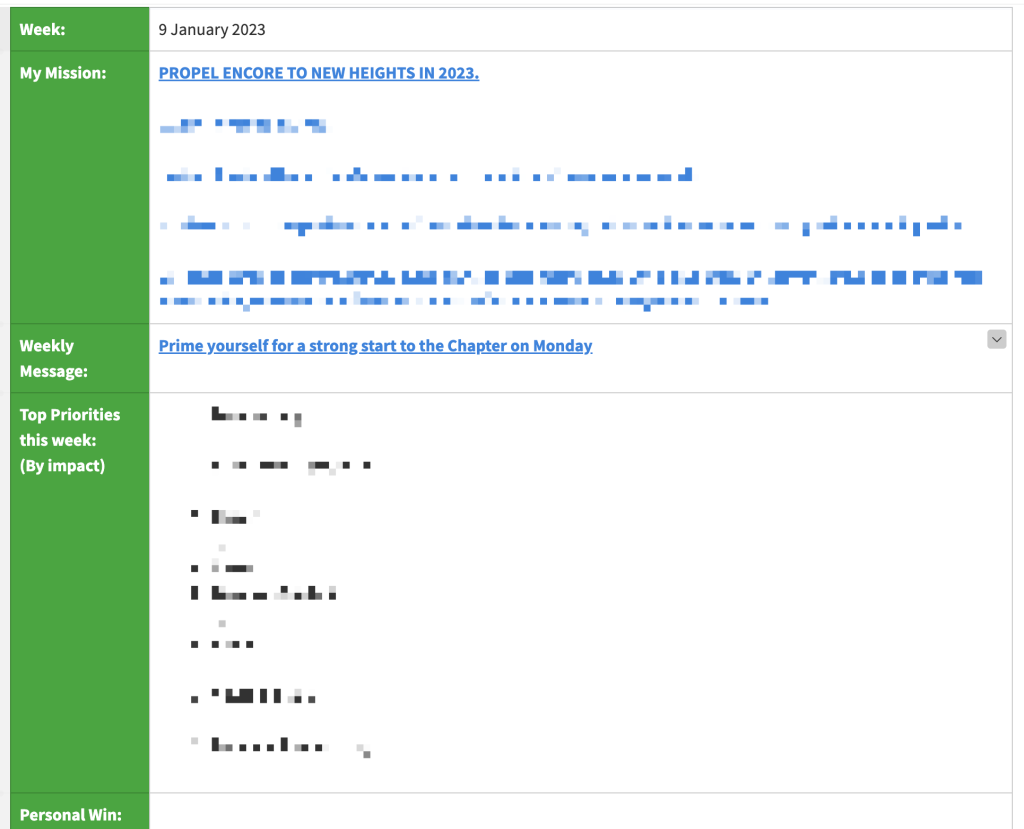
A reminder of my own personal Mission. This evolves with the seasons. Right now, it’s “PROPEL ENCORE TO NEW HEIGHTS IN 2023.”
A Weekly Message. This can be a mantra or an intention for the week. Last week, it was “Prime yourself for a strong start to the Chapter on Monday” (we work in 2-month Chapters instead of 3-month quarters)
Top Priorities for the Week: this is the most important section of the journal, and I try to spend the most time on this section. If I get my priorities right at the start of the week, and if my calendar truly reflects my priorities (more on this later) then I’m a lot more likely to have a productive five days. If my priorities are unclear, or if I don’t spend time really embracing them on a Monday morning, I’m more likely to get pulled into non-important work.
The critical part of this section is getting the order of your priorities correct. Being clear on your top three priorities is a good start, but doing the work to accurately rank the is what really sets me up for an effective week.
The Personal Win section is where I set aside a bonus task for the week. It’s not necessarily mission critical, but it can be something I really want to do for personal reasons, or simply because it’s a fun piece of work, that I’ll squeeze in if I get everything else done.
I then work through two checklists. The first one asks me to:
✅ Review last weeks plan
✅ Think – are there any icebergs on route?
✅ Reschedule overdue TODOs in Todoist
✅ Block out Calendar Time for Priorities
✅ Mark START and END of each day
The first three are self-explanatory.
The final step emerged from a particularly valuable coaching session last year. There was a busy period during the Summer where I had slipped into a routine of working late into the evenings, and as we all know, working late is a game of diminishing returns.
To combat this, I experimented with setting an END TIME for each working day at the start of the week, based on my schedule.
If I didn’t have evening plans that would force me to stop working, I found that adding a simple event to my calendar at, say, 7.30pm, saying “STOP WORKING” would help me switch off at the end of the day.
It would also help me view my working day as finite. I’m really productive on days where I need to finish work at 6.30pm or 7pm, and I’m less productive if I take a more expansive view of time and think “I’ve got all evening to work on this, I’ll come back to it later“. Constraints breed results.
Blocking out Calendar Time for my top priorities is the single most important part of this journal.
How we spend our time is a reflection of our priorities.
In many (but not all) cases, when someone says they “didn’t have time” to get something done, they’re really saying that they didn’t prioritise it above other things.
Let’s say, for example, I’ve told my coach that my top priority over the next two weeks i, to completely revamp our financial model. Two weeks pass, and in our next coaching session, I tell her I only spent an hour working on the model since our last session. Either the financial model wasn’t truly a top priority for me, or I allowed myself to be distracted by other work that was a lot less important.
On a Friday afternoon, just before ending the week, I’ll block out time in my calendar for the most important type of work (e.g. hiring, or fundraising). On Monday morning, I’ll then check that my allocation of time reflects my top priorities.
If my top priority is hiring, but I only have 3 hours of interviews scheduled and 3 hours of focused sourcing blocked out in a week with 37.5 hours available, then I’m either kidding myself that hiring is really my top priority, or I need to block out a lot more time for hiring.
To make this time, I’ll cut, reschedule, or shorten any meetings I can, and will shuffle things around until the bulk of my time is being spent on the most important projects.
The second checklist asks me:
✅ Am I doing the most effective thing for the company?
✅ Any meetings we could cut?
✅ How are my evenings looking?
✅ Am I training enough?
The question on evenings prompts me to look at the week as a whole, and check whether I have at least one evening ‘off’ where I’m not going somewhere, meeting people, or doing something that could deplete my energy instead of recharging it.
An evening ‘off’ can still involve going for a run, or meeting a close friend, but it’s supposed to be downtime where I can recharge. On weeks where I have something on every night, I end up shattered by Friday.
The “Am I training enough?” question is also designed to help me manage my energy levels. I’ve noticed that I start to feel quite lethargic when I’m not doing much exercise, so I view daily training as a way of energising myself at work and keeping my mind clear. I’ll write more about this another time.
Finally, I answer three questions designed to:
- unearth any subliminal unease about the week
- crystallise any latent excitement, and
- galvanise me
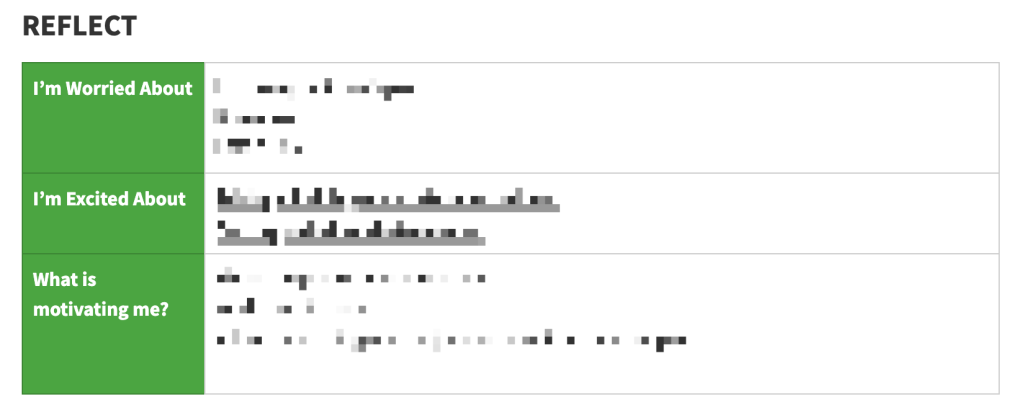
- What am I worried about?
- Journaling even briefly on this prompt can help me bring subconscious concerns to the surface, and often causes me to go back and tweak my priorities for the week to address those concerns
- What am I excited about?
- There are weeks where I’m in a state of perpetual excitement and answering this prompt doesn’t do much for me. There are also weeks where that excitement takes a back seat to high-pressure demands or problems, and I find this prompt particularly helpful during those challenging periods when it can be easier to lose sight of the exciting parts of my work
- What is motivating me?
- Writing this down every week reinforces my motivations. Simple as that.
I can’t take any credit for this journaling format. I borrowed and adjusted a fantastic template from Ben Gateley at CharlieHR:
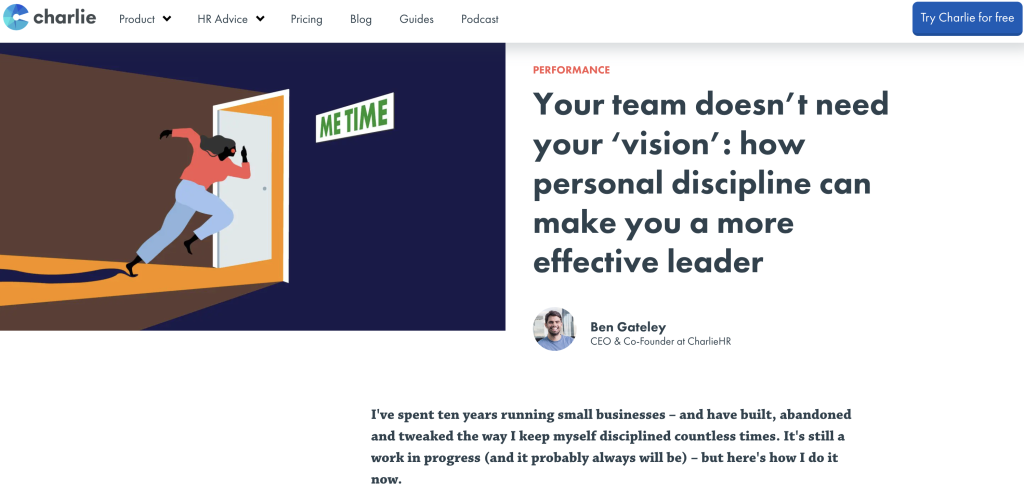
If it’s done properly, this journal takes me about 30 minutes on a Monday morning, and the ROI on those 30 minutes is high.
It’s the most pivotal part of my week that ensures I’m moving in the right direction and focusing on the right projects.
On the weeks where I hastily dive into work without filling the journal out and properly assessing the relationship between my calendar and my priorities, my week is typically ‘busy’ but ultimately unproductive.
Getting into short bursts of flow
In Deep Work, Cal Newport talks about four philosophies for deep work:

I’ve found the Journalistic approach to be the most suitable for my role.
In an ideal week, I’ll block out an afternoon to work on one project, or a morning to get into flow and completely solve a problem.
In non-ideal weeks, I’ll have meetings and other commitments scattered throughout the week, so I need to get focused work done in short bursts of 25 or 50 minutes.
Why 25 minutes?
I’ve been using the pomodoro technique since uni, and I’ve found that 25 minutes, for me, is the sweetspot for focus. If I get really deep into flow, I’ll abandon pomodoro and just work until I’m tired, but most days I aim to work in 25-minute bursts.
To do this, I use an incredible app called Session.
Session Timer
At its core, Session is simply a well-designed timer app.
You select a length of time, hit start, and the timer counts down in your menu bar.
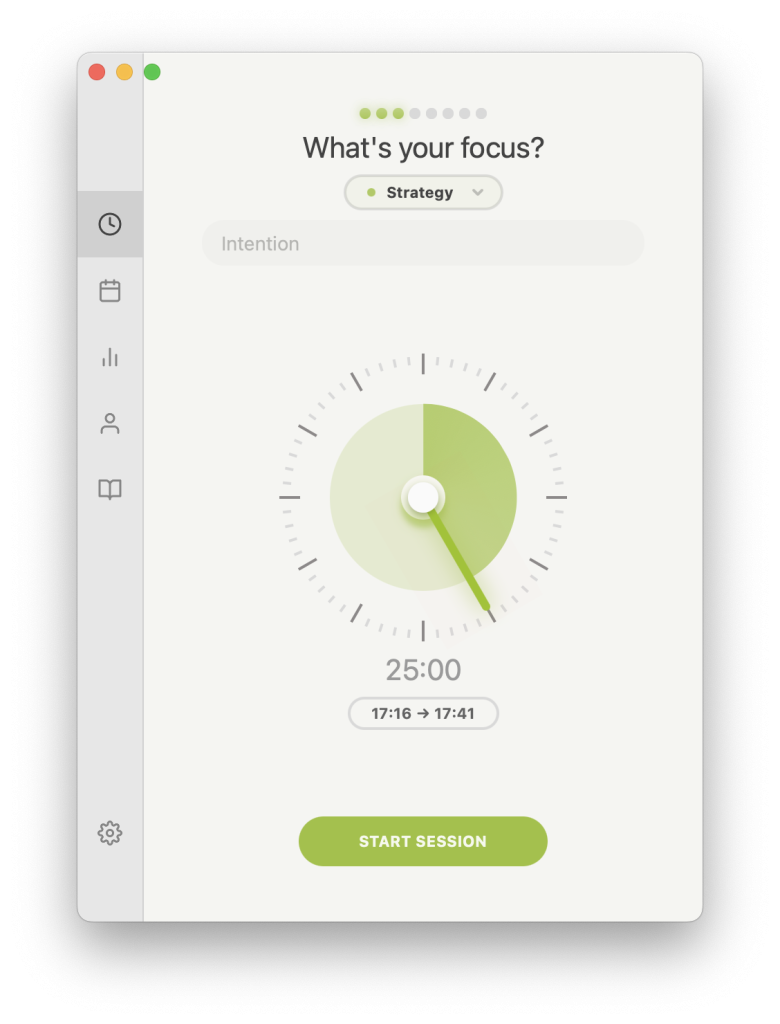
You can select a category for focus session (e.g. Strategy in the screenshot above), and Session will show you stats on how you’re spending your time each day, and each week. I don’t use these stats very often, but they’re interesting to look at from time to time.
Another neat feature is a Slack integration that changes your Slack status to “Focused” and switches on Do Not Disturb mode. This reduces distractions from Slack (though I already have notifications switched off) and lets your team know that you’re in the zone until a certain time.
In parallel with Session, I use an ambient noise app called A Soft Murmur.
A Soft Murmur
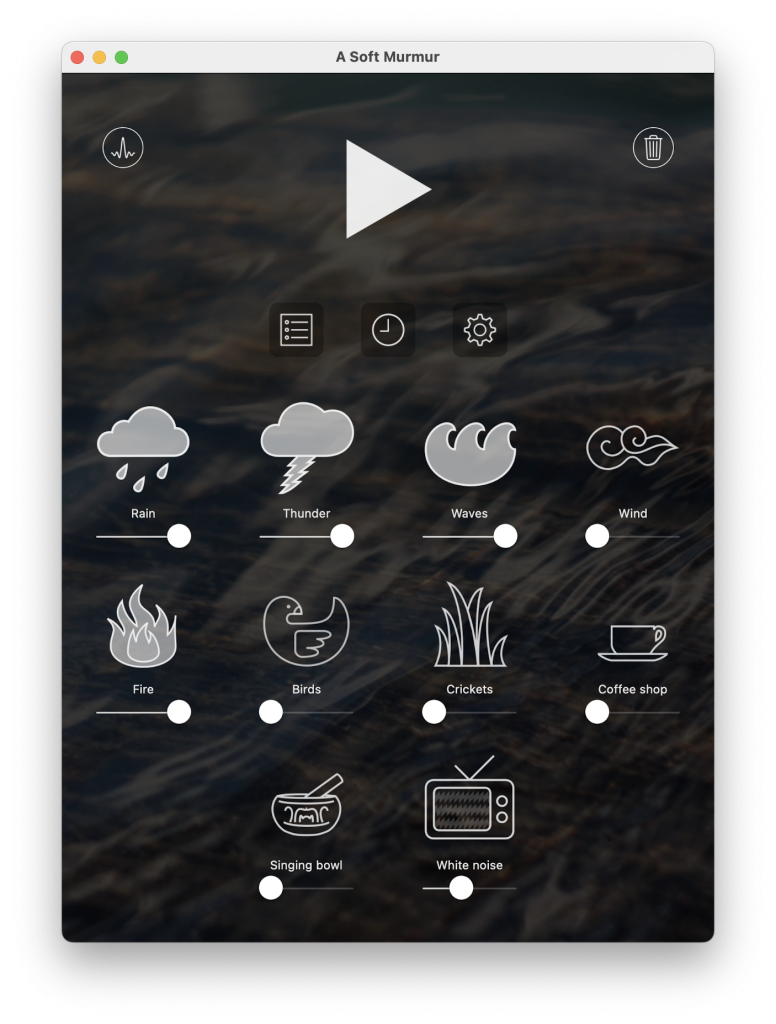
Again, a simple app with a single purpose: to create background noise that drowns out distraction and helps me get into the zone.
I like to hear rain, thunder, waves, and sometimes a crackling fire. It’s grounding, and it’s similar to white noise without being mind-numbing.
By playing this sound every time I’m getting into a focused piece of work, I’ve created a surprisingly strong sonic association and have been able to train my mind to drop into a state of focus on-command.
Leaving my personal phone in another room
After eight years of building Encore, this week I finally set up a dedicated work phone to gain better separation between my personal down time and my focused work time.
To say this has been revolutionary for my wellbeing would be an understatement, and I’m going to write more about that in another post soon.
Until this week, I was using WhatsApp for both professional and personal conversations, which meant I had WhatsApp open throughout the working day. I once counted the number of active conversations I had in a single week and it was 50, which had become overwhelming and highly distracting.
“Out of sight, out of mind” is the name of the game here, and having my personal phone in a different room or simply out of reach makes a big difference to my level of focus.
Noise-cancelling headphones
I’m easily distracted by background noise, especially chatter in the office, so noise-cancelling headphones are a non-negotiable for me.

I had been using the Sennheiser Quiet Comfort 25s since 2018, which had fantastic sound quality and impressive noise-cancelling.
The main downside was the wired connection, which meant I had to carry an adapter around to use them on phonecalls. They were also quite clunky, and using them on the go or carrying them between meeting rooms was a faff.

This week, I switched to the Sony WF1000XM4 in-ears, which have been fantastic so far.
The sound quality and noise-cancelling are roughly on a par with the Bose, but the bluetooth connection and tiny size make them much more convenient on days where I’m not working from home all day.
My only gripe is with the microphone quality, which doesn’t sound crystal clear if there’s even minimal background noise, but it’s not a dealbreaker.
So that’s my current setup.
It’s worth saying that this system is good, but it’s not bulletproof; the whole system falls down if I don’t plan my week properly and manage my calendar inline with my priorities, and it requires a daily commitment to using the Session timer and sticking to the focus blocks in the calendar.
When I commit to the process, it’s highly effective, and it’s the best system I’ve found yet.
